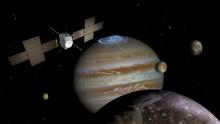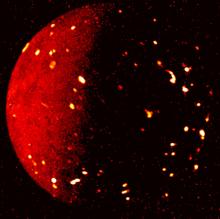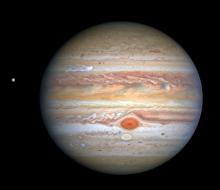Listen to today's episode of StarDate on the web the same day it airs in high-quality streaming audio without any extra ads or announcements. Choose a $8 one-month pass, or listen every day for a year for just $30.
You are here
Moon and Planets
The solar system gets the week off to a beautiful start early tomorrow. The Moon will form a wide triangle with the planets Jupiter and Saturn. The trio will climb into view after midnight and stand high in the south at first light. Jupiter is the brighter of the two planets, and stays to the left of the Moon, with Saturn to the right of the Moon.
Jupiter and Saturn are the largest planets in the solar system. And not surprisingly, they have the largest collections of moons — almost 80 for Jupiter, and more than 80 for Saturn.
Many of those moons have been discovered just in the last couple of decades. That’s because most of them are tiny — no more than a few miles in diameter — so they’re faint. And they’re a long way out from the planets, so astronomers have to search a large area to find them.
Some of the little guys probably were asteroids that were captured when they passed close to one of the planets. And some appear to be remnants of larger moons that were blasted to bits by collisions.
Instead of Greek and Roman mythology, the names for some of the moons of Saturn have been drawn from other cultures — Gallic, Norse, and Inuit. And some moons of both worlds haven’t been named yet. In some cases, that’s because astronomers are waiting for confirmation that the moons actually exist. Until then, they’re stuck with catalog numbers — waiting for full membership in these giant families of moons.
Script by Damond Benningfield





